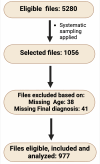Hypertensive crisis: Insights into prevalence and associated factors at a tertiary care facility in Zambia
- PMID: 40392876
- PMCID: PMC12091803
- DOI: 10.1371/journal.pgph.0004649
Hypertensive crisis: Insights into prevalence and associated factors at a tertiary care facility in Zambia
Abstract
Background: Hypertensive crisis, including hypertensive emergency (with target organ damage) and hypertensive urgency (without target organ damage), is a critical public health condition at Livingstone University Teaching Hospital (LUTH). Hypertensive crisis has been linked to severe complications, including stroke, renal failure, and heart disease, leading to increased mortality, morbidity, and healthcare costs due to intensive treatment, prolonged hospital stays, and long-term care. This study aimed to determine the prevalence and factors associated with hypertensive crisis among patients presenting at the adult medical emergency department at LUTH.
Method: This was a retrospective cross-sectional study conducted among 977 individuals aged ≥ 18 years who visited the facility between 1st January and 31st December 2021. Hypertensive crisis was defined as systolic BP ≥ 180 mmHg and diastolic BP ≥ 120 mmHg, with or without target organ damage by the attending clinician. Multivariable logistic regression was used to evaluate factors associated with hypertensive crisis. Statistical significance was set at p < 0.05.
Results: The prevalence of hypertensive crisis was 18.9% (95% CI: 17%, 21%) [(n = 185/977)], with 1.1% (n = 11) diagnosed with hypertensive emergency and 17.8% (n = 174) with hypertensive urgency. The most affected group was under 45 years old (n = 89, 48.1%), and Males [50.8%, (n = 94)] and females [49.2%, (n = 92)] were equally affected. Individuals who did not adhere to their hypertension medication were 6.3 times more likely to experience a hypertensive crisis compared to those who adhered (AOR: 6.3; 95% CI: 2.78-13.01; p < 0.001). Individuals in employment were 3.94 times more likely to experience a hypertensive crisis compared to those who were unemployed (AOR: 3.94; 95% CI: 1.52-10.21; p = 0.005). Similarly, individuals diagnosed with a hypertensive crisis had 3.43 times higher odds of being hospitalized than those who were not diagnosed (AOR: 3.43; 95% CI: 1.61-7.34; p < 0.001).
Conclusion: Hypertensive crisis represents a significant burden on our emergency department, which may lead to severe complications such as stroke, renal failure, and cardiovascular events. These complications, in turn, result in increased healthcare costs and patient morbidity in resource-limited settings like ours. Therefore, there is a need to enhance public awareness about hypertension and adopt a patient-centered approach to medication adherence.
Copyright: © 2025 Siame et al. This is an open access article distributed under the terms of the Creative Commons Attribution License, which permits unrestricted use, distribution, and reproduction in any medium, provided the original author and source are credited.
Conflict of interest statement
The authors have declared that no competing interests exist.
Similar articles
-
Characteristics and factors associated with hypertensive crisis: a cross-sectional study in patients with hypertension receiving care in a tertiary hospital.Ann Med Surg (Lond). 2023 Sep 7;85(10):4816-4823. doi: 10.1097/MS9.0000000000001250. eCollection 2023 Oct. Ann Med Surg (Lond). 2023. PMID: 37811010 Free PMC article.
-
Prevalence of Hypertensive Emergency and Associated Factors Among Hospitalized Patients with Hypertensive Crisis: A Retrospective Cross-Sectional Study.Integr Blood Press Control. 2020 Aug 18;13:95-102. doi: 10.2147/IBPC.S265183. eCollection 2020. Integr Blood Press Control. 2020. PMID: 32904390 Free PMC article.
-
Risk factors for hypertensive crisis in adult patients: a systematic review.JBI Evid Synth. 2021 Jun;19(6):1292-1327. doi: 10.11124/JBIES-20-00243. JBI Evid Synth. 2021. PMID: 33555818
-
Prevalence and risk factors for hypertensive crisis in a predominantly African American inner-city community.Blood Press. 2019 Apr;28(2):114-123. doi: 10.1080/08037051.2019.1568183. Epub 2019 Jan 22. Blood Press. 2019. PMID: 30669866
-
Hypertensive crisis and its predictors in Africa: Systematic review and meta-analysis, 2024.Int J Cardiol Cardiovasc Risk Prev. 2024 May 15;21:200285. doi: 10.1016/j.ijcrp.2024.200285. eCollection 2024 Jun. Int J Cardiol Cardiovasc Risk Prev. 2024. PMID: 38828464 Free PMC article. Review.
References
-
- World Health Organisation. Global report on hypertension. 2023. [cited 4 Jul 2024]. Available from: https://www.who.int/teams/noncommunicable-diseases/hypertension-report
-
- Kilindimo SS, Abdulkarim A, Simbila AN, Harrison R, Shirima L, Abdallah F, et al.. The burden and management strategies of hypertensive crisis in adult patients presenting to emergency departments of district and regional hospitals in Sub-Saharan Africa. Clin Hypertens. 2023;29(1):27. doi: 10.1186/s40885-023-00251-8 - DOI - PMC - PubMed
LinkOut - more resources
Full Text Sources

